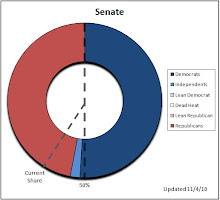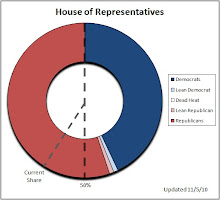It has passed. House Resolution 4872, the reconciliation bill which “fixes” the health insurance industry and addresses the crisis of out-of-control healthcare costs won passage by a vote of 219 to 212 in the US House of Representatives. We have been promised that the bill will expand health insurance coverage to 95% of Americans, decrease premiums across the board, and save the lives of tens of thousands of Americans every year. On top of that, it will decrease the deficit by more than a hundred billion dollars over the next ten years and more than a trillion dollars over the ten years after that. The bill has been characterized as this generation’s Social Security or Civil Rights Act.
At the same time, we are told that this bill shreds the Constitution. We are told that it defies all logic and reason and that it represents the dawning of a new Socialist America. It will forever consume the nation’s finances which are doomed to eternal red ink and bondage to China and India. Its manifestation will be lines that will lead to the sick dying in the streets outside of hospitals with no access to the healthcare system they desperately need.
So, who is right? How can rational people come to such divergent views of the same piece of legislation? How did it come to this? I hope to touch on the answers to all of these questions as I analyze the process of the healthcare bill, the essence of the bill itself, and the alternative that never was. I will also give my thoughts on where we go from here.
The Process
“Laws are like sausages, it is better not to see them being made.” – Otto von Bismarck
The formation of this health care bill will go down in history as a case study for political scientists and parliamentarians. It is a unique example of legislative behavior in the face of unbelievable pressures from every side. The passions that exist in the mere mentioning of health care forge a debate that is very difficult to win.
Some view access to affordable health care as a basic right which must be protected no matter the cost. They believe that covering the uninsured saves lives and is therefore worthy of any expense.
Others believe that the government is an inefficient manager, guilty of corruption at every level. They see regulation and management as power grabs intent on defying individual choice and liberty, the essence of what they believe to be the soul of America.
When these forces collide, it produces a train wreck with many casualties and Washington, D.C. is where it all went down.
President Obama, Speaker Nancy Pelosi, and Majority Leader Harry Reid represent an ideological bulwark for the first set of people. They believe that the government must facilitate however necessary the complete access to healthcare they deserve. They set their sights on a very high target, a radical and complete overhaul of the United States health care system.
You can see this in the words of President Obama back during the campaign. “I believe absolutely passionately,” he said, “that we must have universal health care. It is a moral responsibility and a right for our country.” He favored a public option that would allow government to provide coverage to those who have no private insurance plan.
With significant majorities in the House and the Senate and control of the White House, this team saw their opportunity to achieve what they had hoped for. They sought to pass the most expansive bill they could.
Then came the opposition. The public option was dropped to gain the support of some who saw the bill as simply too much to swallow. Deals were made and kickbacks were added. The bill grew to a length of more than 2,000 pages.
Constituents began to find buried in these thousands of pages taxes and expenses that were not as advertised. They saw mandates and regulations that reduced their choices in the name of expanding them. They were encouraged by sympathetic members of Congress and media to voice their concerns, but those concerns were always there. This is the second set of people I mentioned earlier, distrustful of government bureaucracy, ever wary of federal expansion.
The Tea Party movement was born as town hall meetings were swamped and rallies were formed across the country. Before long, popular opinion began to indicate a steady and significant erosion of support for the bill. A CNN poll conducted in June of 2008 indicated that 51% of Americans supported President Obama’s health care bill. At the time of the bill’s passage, a new CNN poll indicated that number had fallen all the way to 39%.
This popular unrest helped spark a Republican revival with victories in Virginia and New Jersey. It led to the ultimate victory of Scott Brown in the Massachusetts Senate Race, which sent violent shockwaves through Capitol Hill. It was a new shot heard round the world from Massachusetts.
Though separate bills had already passed the House and the Senate, negotiations broke down and the fate of healthcare legislation seemed dead with the loss of a supermajority in the Senate.
Democratic leadership faced a legislature scrambling for cover, many of their members representing districts that voted for John McCain, even more in districts with significant disapproval of this bill; however, the leadership would not give up.
They found a parliamentary rule that had been passed in order to facilitate budget proceedings and cut wasteful spending: the budget reconciliation. This allows for a bill, after being passed by the chamber, to be amended under strict rules. It eliminates the filibuster which allows for a simple majority to prevail so long as the amendment can be demonstrated to reduce the deficit and all of its parts are germane to that cause.
So, leadership went hard at work to create a reconciliation amendment which would meet these requirements. In the end, they produced a package that the CBO projected to reduce the deficit. Still, there were many parliamentary questions that remained.
The bill was not law and had to become law before it could be amended by the reconciliation. This meant that the Senate bill had to be passed by the House before reconciliation could be acted upon. The Senate bill was loaded with unpopular special deals and questionable treatment of abortion funding which made it incredibly radioactive for many House members.
This is where Speaker Pelosi stepped in with the so-called “Slaughter Solution,” or “deem-and-pass.” It meant that the House would simply deem the Senate bill passed without voting on it. Instead, they would attach a rule to their passage of the reconciliation bill that stated that the Senate bill was passed if the reconciliation bill became law. Ultimately, this idea was scrapped as it did not win the support of people who felt it was just a way to avoid accountability.
Still, a group of Democrats aligning themselves with Bart Stupak, a Democrat from Michigan, threatened the passage of the reconciliation bill which did not keep the original House language on abortion. Uncomfortable with the potential federal funding of abortion the bill could open the door to, the bloc was enough to determine the outcome of the bill.
So, negotiations began. At first, it seemed as though a deal would be struck to amend the reconciliation bill itself. The parliamentary procedure for this is questionable and would only complicate the process even further. Fortunately for parliamentarians, this idea didn’t last long as an even larger contingent of pro-choice Democrats squashed the opportunity by threatening to walk out on the bill should such an amendment be added.
Literally the day of the vote, only a few hours before the final vote was held in the House Chamber, a deal was struck between Bart Stupak and President Obama. An executive order would be issued declaring that the bill shall not be interpreted to indicate that any federal funding should be provided for abortion. The agreement was substantive enough to satisfy Stupak and his allies while also remaining distant enough for the pro-choice Democrats to put up with it.
Finally, the bill passed. With enormous political opposition, the Democratic leadership was able to guide a monstrous bill through a minefield. Public support had completely eroded and numerous Congressmen risked their jobs to vote for the bill. By the end of the process, Congressional approval had dropped from 35% in June to 19%. Still, the bill had passed.
Applying common sense to politics...










3 comments:
Very good summary. Look forward to your explanation of the extremely different views on the consequences of this legislation and what we can do to stop it.
I wonder which polls you take. They are so often 'minefields' of inaccurate questions to make ones point seem valid.
There are two web sites, primarily, that I use as sources for my polls.
http://www.realclearpolitics.com
http://www.pollster.com
These two web sites provide averages of all scientific polling conducted by groups from Rasmussen to PPP to Field to Gallup to CNN to CBS. They are both really good sources.
Specifically in this post, I used the CNN poll to show a drop in approval of the bill. It demonstrates that even a poll conducted in the same way and the same source which is generally well trusted shows a drastic decline in public support for the bill. If you visit either of the web sites I just listed you will find that other polling services reflect almost exactly the same numbers.
The Congressional Approval ratings I provide here are the RealClearPolitics averages.
You do have to be very careful with polls. For instance, all of a sudden the day after the bill passed a new poll was released by Gallup which showed that 49% of Americans thought the passing of the bill was a "good thing." When you compare this, though, with every single major poll conducted in the last month on health care, it is nearly 10 points higher than the average. Gallup also has a record of being on the high end of the polls throughout the entire debate.
Rest assured, though, that any polls I use on my blog will be well-researched and substantial. I know full and well the dangers of using a weak poll.
Post a Comment